Voter registration in the United States
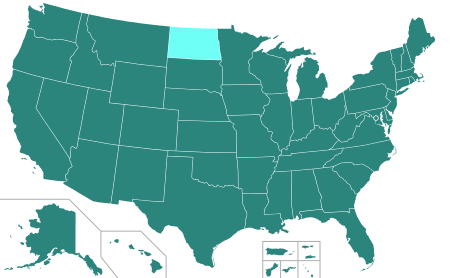
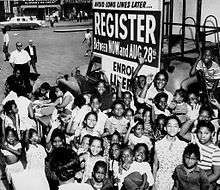
Voter registration in the United States takes place at the county level in many states and at the municipal level in several states, and is a prerequisite to voting at federal, state and local elections. The only exception is North Dakota, which does not require registration, although North Dakota law allows cities to register voters for city elections.[1][2] The majority of states set cutoff dates for voter registration, ranging from 2 to 4 weeks before an election; while a third of states have Election Day or "same-day" voter registration which enables eligible citizens to register or update their registration when they vote before or on Election Day.
It has been argued that some registration requirements deter some people (especially disadvantaged people) from registering and therefore exercising their right to vote, resulting in a lower voter turnout. According to a 2012 study, 24% of the voting-eligible population in the United States are not registered to vote, equaling some 51 million U.S. citizens. While voters traditionally had to register at government offices by a certain period of time before an election, in the mid-1990s, the federal government made efforts to facilitate registering, in an attempt to increase turnout. The National Voter Registration Act of 1993 (the "Motor Voter" law) now requires state governments to either provide uniform opt-in registration services through drivers' license registration centers, disability centers, schools, libraries, and mail-in registration, or to allow Election Day voter registration, where voters can register at polling places immediately prior to voting. In 2016, Oregon became the first state to make voter registration fully automatic (opt-out) when issuing driver licenses and ID cards, since followed by four more states. Political parties and other organizations sometimes hold voter registration drives to register new voters.
In most states, persons registering to vote may at the same time declare an affiliation with a political party.[3]
Federal jurisdiction
While the United States Congress has jurisdiction over laws applying to federal elections, it has deferred the making of most aspects of election laws to the states. The United States Constitution prohibits states from restricting voting rights in ways that infringe on a person's right to equal protection under the law (14th Amendment), on the basis of race (15th Amendment), on the basis of sex (19th Amendment), on the basis of having failed to pay a poll tax or any tax (24th Amendment), or on the basis of age for persons age 18 and older (26th Amendment). The administration of elections, however, vary widely across jurisdictions.
Only US citizens have the right to vote in federal elections.[4] In a few cases, permanent residents ("green card" holders) have registered to vote and have cast ballots without realizing that doing so was illegal. Non-citizens convicted in criminal court of having made a false claim of citizenship for the purpose of registering to vote in a federal election can be fined and imprisoned for up to a year. Deportation and removal proceedings have resulted from several such cases.[5] Some states prohibit convicted felons from voting, a practice known as felony disenfranchisement. Of these states, some prohibit voting only during parole or probation but allow voting after. A small number of states may require repeat offenders to have their voting rights restored through court action.[6]
Effect on participation
A 2012 study by The Pew Charitable Trusts estimates that 24% of the voting-eligible population in the United States are not registered to vote, a percentage that represents "at least 51 million eligible U.S. citizens."[7][8] the study suggests that registration requirements contribute to discouraging people from exercising their right to vote, thereby causing a lower voter turnout. The extent of discouragement and its effect on increasing the socioeconomic bias of the electorate however remain contested.
In a 1980 landmark study, Raymond E. Wolfinger and Steven J. Rosenstone came to the conclusion that less restrictive registration requirements would substantially increase the electoral turnout. According to their probit analysis, if all states adopted the procedures of the most permissive state regulations, which would mean:
- eliminating the closing date
- opening registration offices during the forty-hour work week
- opening registration offices in the evening or on Saturday
- permitting absentee registration for the sick, disabled and absent
(p 73) turnout in the 1972 presidential election would have been 9.1% higher, with 12.2 million additional people having voted.[9] In a seminal 1988 book, sociologists Richard Cloward and Francis Fox Piven argued that lowering registration requirements would improve socioeconomic equality in the composition of the electorate.[10]
Findings such as this have inspired lawmakers to facilitate the registration process, eventually leading to the National Voter Registration Act of 1993 (or "Motor Voter" act) that required states to allow voter registration at various public offices, including drivers' license registration centers, disability centers, schools, libraries, as well as mail-in registration, unless a state adopts Election Day voter registration. The way towards passing this piece of federal legislation was however lengthy and rocky, as these reforms were highly contested. In an expanded 1990 edition of their 1988 book, titled "Why Americans still don't vote: and why politicians want it that way," Cloward and Piven argued that the reforms were expected to encourage less-privileged groups which happen to lean towards the Democratic Party.[11]
While the turnout at federal elections did substantially increase following the electoral reforms, the effect fell short of Wolfinger and Rosenstone's expectations while Cloward's and Piven's hope of improving the demographic representativeness of the electorate wasn't fulfilled at all. Political scientist Adam Berinsky concluded in a 2005 article that the reforms designed to make voting "easier" in their entirety had an opposite effect, actually increasing the preexisting socioeconomic biases by ensuring "that those citizens who are most engaged with the political world – those with politically relevant resources – continue to participate, whereas those individuals without such resources fall by the wayside."[12] As Berinsky reaffirms in a 2016 piece, the only way to increase turnout while improving representativeness is making more people become interested in politics.[13]
Forms of facilitation
Registration centers
Traditionally, voters have had to register at government offices to vote, but in 1993 Congress passed the National Voter Registration Act of 1993, also known as the "Motor Voter" law, which came into effect on January 1, 1995, to make registering easier, in an attempt to increase turnout. The law requires state governments to provide opt-in registration services through drivers' license registration centers, disability centers, schools, libraries, and mail-in registration, though the States which since March 11, 1993, have not required voter registration for federal elections or had same-day voter registration on Election Day were exempt from the Act. Six states qualify for the exemption: North Dakota (which does not have registration), Idaho, Minnesota, New Hampshire, Wisconsin and Wyoming.
Online voter registration
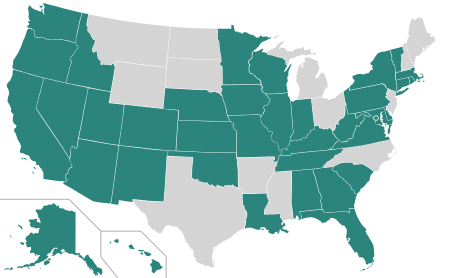
As of December 6, 2017, 37 states and the District of Columbia offer online registration, along with one other state (Oklahoma) that has passed legislation to create online voter registration systems, but not yet implemented it.[14]
- ↑ In Missouri, a person can register to vote online and electronically provide a signature using a mobile device, tablet computer or touchscreen computer, but not a standard desktop computer. The state reviews the information and prints out the registration form, which it sends to the person's local elections office for verification.
- ↑ In Missouri, a person can register to vote online and electronically provide a signature using a mobile device, tablet computer or touchscreen computer, but not a standard desktop computer. The state reviews the information and prints out the registration form, which it sends to the person's local elections office for verification.
Automatic voter registration
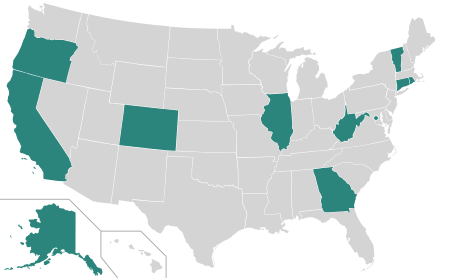
As of October 9, 2018, 8 states and the District of Columbia provide automatic registration when citizens interact with state agencies such as the DMV, along with 4 other states that has passed legislation to create automatic registration systems, but not yet implemented it.[42] Those interacting with the state agencies have the option to opt-out of registering.
From January 1, 2016, Oregon implemented the Motor Voter Act, a fully automatic (opt-out) voter registration system tied into the process of issuing driver licenses and ID cards.[43] By April 2016 three more states – California, West Virginia, and Vermont – had followed suit, and in May 2016 Connecticut announced plans to implement it administratively rather than by legislation, bringing the number of states with automatic voter registration policies to five.[44][45] Alaskan voters approved Measure 1 during the November 8, 2016, general election, allowing residents the ability to register to vote when applying annually for the state's Permanent Dividend Fund.[46][47] Voter approval of Measure 1 made Alaska the first state to implement automatic (opt-in) voter registration via ballot initiative and the sixth state to implement automatic registration by any means including passing legislation. Several more states have considered legislation for automatic registration.[48] On August 28, 2017, Governor Bruce Rauner signed Illinois SB1933, which sets implementation of automatic voter registration at motor vehicle agencies for July 1, 2018, and a year later at other state agencies.[49]
| Federal district or state | Automatic voter registration implemented |
|---|---|
| 2017/03/01[50] | |
| 2017/04/?[42] | |
| 2017/02/?[42] | |
| 2018/06/26[51] | |
| 2016/09/?[42] | |
| 2018/07/02[52] | |
| 2019/07/?[42] | |
| 2018/11/?[42] | |
| 2016/01/01[53] | |
| 2018/06/?[42] | |
| 2017/01/?[42] | |
| 2019/07/?[42] | |
| 2019/07/?[42] | |
| 2020/01[42] |
Election Day voter registration / same-day voter registration
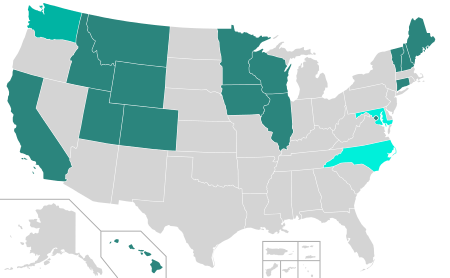
The majority of states require voters to register two to four weeks before an election, with cutoff dates varying from 30 to 15 days.
Some states allow Election Day voter registration (also known as EDR) which enables eligible citizens to register to vote or update their registration when they arrive to vote. Some states call the procedure same-day registration (SDR) because voters can register and vote during an earlier voting period before Election Day.
EDR allows eligible citizens to register or update their registration at the polls or their local election office by showing valid identification to a poll worker or election official, who checks the identification, consults the registration list and, if they are not registered or the registration is out of date, registers them on the spot.
As of March 27, 2018, 17 states and the District of Columbia offer same day voter registration, which allows any qualified resident of the state to go to register to vote and cast a ballot all in that day. Additionally, 1 state (Washington) has enacted same day vote registration, which has yet to be implemented.[54] Also, 9 states have voter registration possible for a portion of their early voting periods.
Five states are exempt from the National Voter Registration Act of 1993 because they have continuously since 1993 had EDR: Idaho, Minnesota, New Hampshire, Wisconsin and Wyoming. Maine lost the exemption when it abolished EDR in 2011, though it was subsequently restored. North Dakota is also exempt because it does not have a registration requirement. In June 2011, Maine abolished EDR, which had been in place since 1973, and abolished absentee voting during the two business days before an election.[55] However, the stipulation banning EDR was overturned in a November 2011 citizen referendum ("people's veto") titled Question 1,[56] when Maine voters reinstated EDR with 59% in favor.[57]
Voter turnout is much higher in states using EDR than in states that do not. A 2013 report analyzing turnout in the 2012 United States presidential election, had SDR states averaging at a turnout of 71%, well above the average voter turn-out rate of 59% for non-SDR states.[58] According to official turnout data report in the 2014 edition of America Goes to the Polls,[59] voter turnout in EDR states has averaged 10–14 percent higher than states that lack that option.[60] Research suggests that EDR increases turnout between three and fourteen percentage points.[61][62][63][64][65] A 2004 study summarizes the impact of EDR on voter turnout as "about five percentage points".[66]
| Federal district or state | Same day voting registration implemented | Early voting period registration implemented |
|---|---|---|
| ????/??/?[54] | ????/??/?[54] | |
| ????/??/?[54] | ????/??/?[54] | |
| ????/??/?[54] | N/A[54] | |
| ????/??/?[54] | N/A[54] | |
| ????/??/?[54] | ????/??/?[54] | |
| ????/??/?[54] | N/A[54] | |
| ????/??/?[lower-alpha 2][54] | N/A[54] | |
| ????/??/?[54] | ????/??/?[54] | |
| ????/??/?[54] | N/A[54] | |
| N/A[54] | ????/??/?[54] | |
| ????/??/?[54] | N/A[54] | |
| ????/??/?[54] | N/A[54] | |
| ????/??/?[54] | N/A[54] | |
| N/A[54] | ????/??/?[54] | |
| ????/??/?[54] | ????/??/?[54] | |
| ????/??/?[54] | ????/??/?[54] | |
| 2019/??/?[54] | 2019/??/?[54] | |
| ????/??/?[54] | N/A[54] | |
| ????/??/?[54] | N/A[54] |
Permanent & portable voter registration
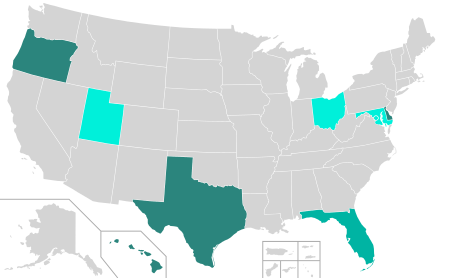
As of 2014, Delaware, Hawaii, Oregon, and Texas allow registered voters who have moved within the state to update their registrations when they vote, and are given a regular ballots when they vote. Florida requires any registered voter who moved to another county and another voting precinct to vote only by a provisional ballot, except if "the precinct to which you have moved has an electronic poll book or you are an active military member", in which case the voter would be giving a regular ballot when they vote. As of 2014, the District of Columbia, Maryland, Ohio, and Utah allow registered voters who have moved within the state or the District of Columbia to vote in their new county without re-registering at their new address, but they can only vote a provisional ballot, which could require further action from the voter before it is counted.[67][68]
Preregistration
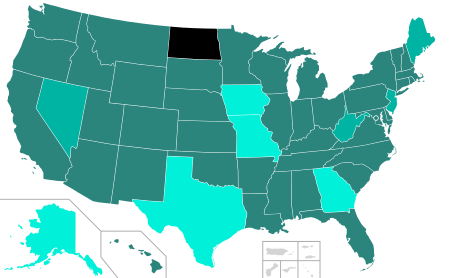
| Federal district of state | Preregistration requirements |
|---|---|
| 18 years old by the election date[69] | |
| Within 90 days preceding 18th birthday[69] | |
| 18 years old by the election date[69] | |
| 18 years old by the election date[69] | |
| 16-year-olds may preregister[69] | |
| 16-year-olds may preregister[69] | |
| 18 years old by the election date[69] | |
| 16-year-olds may preregister[69] | |
| 16-year-olds may preregister[69] | |
| 16-year-olds may preregister[69] | |
| 17.5-year-olds may preregister[69] | |
| 16-year-olds may preregister, and 17-year-olds may register but not vote[69] | |
| 18 years old by the election date[69] | |
| 18 years old by the election date[69] | |
| 18 years old by the election date[69] | |
| 17.5-year-olds may preregister[69] | |
| 18 years old by the election date[69] | |
| 18 years old by the election date[69] | |
| 16-year-olds may preregister[69] | |
| 17-year-olds may preregister[69] | |
| 16-year-olds may preregister[69] | |
| 16-year-olds may preregister[69] | |
| 18 years old by the election date[69] | |
| 18 years old by the election date[69] | |
| 18 years old by the election date[69] | |
| 17.5-year-olds may preregister[69] | |
| 18 years old by the election date[69] | |
| 18 years old by the election date[69] | |
| 17-year-olds may preregister[69] | |
| 18 years old by the election date[69] | |
| 17-year-olds may preregister[69] | |
| 18 years old by the election date[69] | |
| 18 years old by the election date[69] | |
| 16-year-olds may preregister[69] | |
| 18-year-olds by the election date[69] | |
| 18 years old by the election date[69] | |
| 16-year-olds may preregister[69] | |
| 18 years old by the election date[69] | |
| 16-year-olds may preregister, and 17-year-olds may register if they will be 18 years old by the election[69] | |
| 18 years old by the election date[69] | |
| 18 years old by the election date[69] | |
| 18 years old by the election date[69] | |
| Individuals 17 years and 10 months old may register | |
| 16-year-olds may preregister[69] | |
| 18 years old by the election date[69] | |
| 18 years old by the election date[69] | |
| 18 years old by the election date[69] | |
| 17-year-olds may preregister[69] | |
| 18 years old by the election date[69] | |
| 18 years old by the election date[69] |
Voter registration drives

A voter registration drive is an effort undertaken by government authorities as well as political parties and other entities to register to vote all persons otherwise entitled to vote. In many countries the functions of electoral authorities includes endeavours to get as many people to register to vote as possible. In most jurisdictions, registration on the electoral roll is a prerequisite to a person being able to vote at elections.
In the United States, such drives are often undertaken by a political campaign, political party, or other outside groups (partisan and non-partisan), that seeks to register persons who are eligible to vote but are not registered. In all states except North Dakota, registration on the electoral roll in the United States is a prerequisite to a person being able to vote at federal, state or local elections, as well as to serve on juries and perform other civil duties. Sometimes these drives are undertaken for partisan purposes, and target specific demographic groups that are likely to vote for one candidate or other; on the other hand, such drives are sometimes undertaken by non-partisan groups and targeted more generally.
In 2004, the Nu Mu Lambda chapter of Alpha Phi Alpha fraternity held a voter registration drive in DeKalb County, Georgia, from which Georgia Secretary of State Cathy Cox (Dem.) rejected all 63 voter registration applications on the basis that the fraternity did not follow correct procedures, including obtaining specific pre-clearance from the state to conduct their drive. Nu Mu Lambda filed Charles H. Wesley Education Foundation v. Cathy Cox (Wesley v. Cox) on the basis that the Georgia's long-standing policy and practice of rejecting mail-in voter registration applications that were submitted in bundles, by persons other than registrars, deputy registrars, or "authorized persons", violated the requirements of the National Voter Registration Act of 1993 by undermining voter registration drives. A senior U.S. District Judge upheld earlier federal court decisions in the case, which also found private entities have a right, under the federal law, to engage in organized voter registration activity in Georgia at times and locations of their choosing, without the presence or permission of state or local election officials.[70]
Notable national organizations that regularly work to register voters and promote citizens' engagement in elections include:
- Advancement Project
- Close Up Foundation
- Democrats Abroad
- HeadCount
- League of Women Voters
- Let America Vote
- National Association for the Advancement of Colored People
- Nonprofit VOTE
- Our Time
- Rock the Vote
- Southern Regional Council
- Southwest Voter Registration Education Project
- Student Association for Voter Empowerment
- The Voter Participation Center
- U.S. Vote Foundation
- United States Hispanic Chamber of Commerce
- Vote.org
- Voto Latino
Party affiliation
Deadline to re-register with a political party for a partisan primary election
| Federal district of state | Deadline to re-register with a political party for a partisan primary election | Deadline to re-register with a political party for the 2018 United States partisan primary elections |
|---|---|---|
| 29th day prior to the partisan primary election[71] | 2018/05/29[71] | |
| 3 months prior to the partisan primary election[72] | 2018/05/14[73] | |
| The last Saturday in May of the year of the partisan primary election | 2018/05/25[74] | |
| 21st day prior to the partisan primary election[75] | 2018/05/29[75] | |
| 10th Friday prior to the partisan primary election[76][lower-alpha 1] | 2018/03/09[77] | |
| 14th day prior to the partisan primary election[78][lower-alpha 2] | 2018/06/01[79] | |
| December 31 of the year prior to the partisan primary election[80] | 2017/12/31[80] | |
| 15th day prior to the partisan primary election[78][lower-alpha 3] | 2018/05/25[81] | |
| 1st Tuesday of June of the year of the partisan primary election[82][lower-alpha 4] | 2018/06/05[83] | |
| 15th day prior to the partisan primary election[78][lower-alpha 5] | 2018/04/11[84] | |
| 25th day before the general election of the year prior to the partisan primary election[85] | 2017/10/13[86] | |
| 90th day prior to the partisan primary election[87] | 2018/06/14[88] | |
| 14th day prior to the partisan primary election[89] | 2018/08/07[89] |
- ↑ In Idaho, unaffiliated registered voters may re-register up to and on the partisan primary day
- ↑ In Kansas, unaffiliated registered voters may re-register up to and on the partisan primary day
- ↑ In Maine, unenrolled registered voters may re-register up to and on the partisan primary day
- ↑ In New Hampshire, unafflicted registered voters may re-register up to and on the partisan primary day
- ↑ In New Jersey, unaffiliated registered voters may re-register up to and on the partisan primary day
See also
References
- ↑ "The Voter's Self Defense System". Vote Smart. Retrieved August 31, 2017.
- ↑ Secretary of State North Dakota. "Voter Registration in North Dakota". Retrieved August 4, 2010.
- ↑ Navigating Election Day: What Every Voter Needs To Know, Before You Vote Archived October 5, 2006, at the Library of Congress Web Archives
- ↑ "The Right to Vote". United States Citizenship and Immigration Services. Archived from the original on October 17, 2011. Retrieved October 25, 2011.
- ↑ Kirk Semple, ""Immigrants Find Voting Can Come At a Cost". New York Times, October 15, 2010.
- ↑ "Felon Voting Rights". ncsl.org.
- ↑ "Inaccurate, Costly, and Inefficient: Evidence That America's Voter Registration System Needs an Upgrade" (PDF). The Pew Charitable Trusts. February 2012. Retrieved February 16, 2015.
- ↑ "Make It Easy: The Case for Automatic Registration". Democracy. 2013. Retrieved February 16, 2015.
- ↑ Raymond E. Wolfinger and; Steven J. Rosenstone (1980). Who Votes?. Yale University Press. pp. 73, 78. ISBN 0-300-02552-1.
- ↑ Frances Fox Piven; Richard A. Cloward (1988). Why Americans don't vote. Random House. ISBN 0394553969.
- ↑ Toby S. James (2012). Elite Statecraft and Election Administration: Bending the Rules of the Game?. Palgrave Macmillan. ISBN 978-0-230-30842-8.
- ↑ Adam Berinsky (July 2015). "The perverse consequences of electoral reform in the United States" (PDF). American Politics Research. 33 (4): 471–491. doi:10.1177/1532673X04269419.
- ↑ Adam Berinsky (February 8, 2016). "Making Voting Easier Doesn't Increase Turnout". Stanford Social Innovation Review. Retrieved April 7, 2016.
- 1 2 3 4 5 Online Voter Registration
- ↑ You can now register to vote online in Alabama
- 1 2 3 4 5 6 7 8 9 List of States Adopting Electronic Registration, Online Voter Registration, or Both
- ↑ ONLINE VOTER REGISTRATION (OLVR) SYSTEMS IN ARIZONA AND WASHINGTON: EVALUATING USAGE, PUBLIC CONFIDENCE AND IMPLEMENTATION PROCESSES
- ↑ California launches online voter registration
- ↑ Online Voter Registration
- ↑ Voter Registration and Absentee Ballots
- ↑ Office of Elections launches online voter registration system
- ↑ http://www.spokesman.com/blogs/boise/2017/dec/06/idaho-launches-online-voter-registration/
- ↑ Online voting registration begins in Illinois
- ↑ Voter Registration
- ↑ Iowa Residents Can Register to Vote Online
- ↑ Online voter registration comes to Kentucky
- ↑ Online Voter Registration
- ↑ Massachusetts Launches Online Voting Registration System
- ↑ Editorials: Online voter registration offers multiple advantages | Mark Ritchie/PostBulletin
- ↑ Want to register to vote online in Nebraska? Now you can
- ↑ Online Voter Registration Now Available in New Mexico!
- ↑ Ohio's Online Voter Registration System is Now Live
- 1 2 Online Voter Registration
- ↑ Oregon offers online voter registration
- ↑ Pennsylvania Launches Online Voter Registration to Increase Efficiency and Offer Convenience
- ↑ R.I. secretary of state: Voter registration is easier with new online system
- ↑ South Carolina Launches Online Voter Registration System
- ↑ After A Year In The Works, Online Voter Registration Goes Live In Tennessee
- ↑ Online Voter Registration Now Open In Vermont
- ↑ Virginia residents can now register to vote online
- ↑ The Launch of Online Voter Registration in Wisconsin through MyVote.wi.gov
- 1 2 3 4 5 6 7 8 9 10 11 "Automatic Voter Registration". Brennan Center for Justice. July 24, 2018. Retrieved October 10, 2018.
- ↑ "Oregon Secretary of State: Oregon Motor Voter Act FAQ". sos.Oregon.gov. Retrieved August 31, 2017.
- ↑ "Automatic Voter Registration". Brennan Center for Justice. April 1, 2016. Retrieved April 12, 2016.
- ↑ "Shumlin signs into law automatic voter registration". Vermont Business Magazine. April 28, 2016. Retrieved April 28, 2016.
- ↑ Lieutenant Governor Byron Mallott (March 7, 2016). "Proper Filing Letter" (PDF). Alaska Division of Elections. Retrieved December 10, 2016.
- ↑ "Unofficial Results - November 8, 2016 General Election" (PDF). Alaska Division of Elections. November 23, 2016. Retrieved December 10, 2016.
- ↑ "Automatic Voter Registration". Brennan Center for Justice. Retrieved May 12, 2016.
- ↑ "Illinois governor signs automatic voter registration law". Washington Post. August 28, 2017. Retrieved August 31, 2017.
- ↑ PFD Automatic Voter Registration & Updates to Registrations FAQ’s
- ↑ Automatic Voter Registration Begins at DC DMV on June 26, 2018
- ↑ Automatic voter registration at DMV begins in IL
- ↑ Oregon Motor Voter Act FAQ
- 1 2 3 4 5 6 7 8 9 10 11 12 13 14 15 16 17 18 19 20 21 22 23 24 25 26 27 28 29 30 31 32 33 34 35 36 37 38 39 Same Day Voter Registration
- ↑ June 11, 2011,Bill to end same-day registration approved Portland Press Herald
- ↑ August 14, 2011, Citizens rise up in Maine Boston Globe
- ↑ November 8, 2011, Huff Post Politics, Maine Election Day Registration Restored By Voters
- ↑ Timpe, Brenden (March 14, 2013). "New Report: Higher Voter Turnout Linked to SDR". Demos (U.S. think tank). Retrieved May 29, 2013.
- ↑ "America Goes to the Polls 2014 - Nonprofit Vote". www.NonprofitVote.org. Retrieved August 31, 2017.
- ↑ Pillsbury, George; Johannesen, Julian (March 2015). "America Goes to the Polls 2014" (PDF). www.NonprofitVote.org. Nonprofit VOTE.
- ↑ Brians, Craig Leonard; Grofman, Bernard (March 1, 2001). "Election Day Registration's Effect on U.S. Voter Turnout". Social Science Quarterly. 82 (1): 170–183. doi:10.1111/0038-4941.00015. ISSN 1540-6237.
- ↑ Rhine, Staci L. (January 1, 1996). "An Analysis of the Impact of Registration Factors on Turnout in 1992". Political Behavior. 18 (2): 171–185. JSTOR 586605.
- ↑ Ansolabehere, Stephen; Konisky, David M. (December 21, 2006). "The Introduction of Voter Registration and Its Effect on Turnout". Political Analysis. 14 (1): 83–100. doi:10.1093/pan/mpi034. ISSN 1047-1987.
- ↑ Burden, Barry C.; Canon, David T.; Mayer, Kenneth R.; Moynihan, Donald P. (January 1, 2014). "Election Laws, Mobilization, and Turnout: The Unanticipated Consequences of Election Reform". American Journal of Political Science. 58 (1): 95–109. doi:10.1111/ajps.12063. ISSN 1540-5907.
- ↑ Neiheisel, Jacob R.; Burden, Barry C. (July 1, 2012). "The Impact of Election Day Registration on Voter Turnout and Election Outcomes". American Politics Research. 40 (4): 636–664. doi:10.1177/1532673X11432470. ISSN 1532-673X.
- ↑ Highton, Benjamin (September 1, 2004). "Voter Registration and Turnout in the United States". Perspectives on Politics. 2 (03): 507–515. doi:10.1017/S1537592704040307. ISSN 1541-0986.
- ↑ Millions to the Polls
- ↑ FAQ - Voting
- 1 2 3 4 5 6 7 8 9 10 11 12 13 14 15 16 17 18 19 20 21 22 23 24 25 26 27 28 29 30 31 32 33 34 35 36 37 38 39 40 41 42 43 44 45 46 47 48 49 Preregistration for Young Voters
- ↑ Cox Violated Voter Rights, Judge Declares Archived 2014-08-29 at the Wayback Machine.
- 1 2 2018 Election Calendar
- ↑ VOTER REGISTRATION PROCEDURE
- ↑ Deadline looming to switch party before Connecticut primary
- ↑ Party affiliation change deadline approaching
- 1 2 Deadline to change party affiliation status
- ↑ Primary Elections in Idaho
- ↑ Friday is deadline to change party affiliation in Idaho
- 1 2 3 Deadlines to change party affiliation in closed primary states
- ↑ Deadline nears to change party affiliation
- 1 2 Deadline to Change Party Affiliation Ahead of 2018 May Primary is Dec. 31
- ↑ Deadline to Change Party Enrollment in Time to Vote in June 12 Primary
- ↑ Party Affiliation in New Hampshire
- ↑ June 5, 2018 Deadline to Change Party Affiliation for Voting in the September 11, 2018 State Primary Election
- ↑ Division of Elections Reminds Registered Voters of Upcoming April 11 Deadline for Change of Party Affiliation Declaration Forms for Primary Election to be Filed with County Commissioners of Registration
- ↑ New York Consolidated Laws, Election Law - ELN § 5-304. Enrollment; change of enrollment or new enrollment by previously registered voters
- ↑ "PSA: You Have Until October 13th To Change Your Party Registration For The 2018 Primary". Archived from the original on February 24, 2018. Retrieved July 16, 2018.
- ↑ Frequently Asked Questions
- ↑ R.I. voters have until June 14 to switch party affiliations before Sept. 12 primary
- 1 2 Welcome to the FAQs